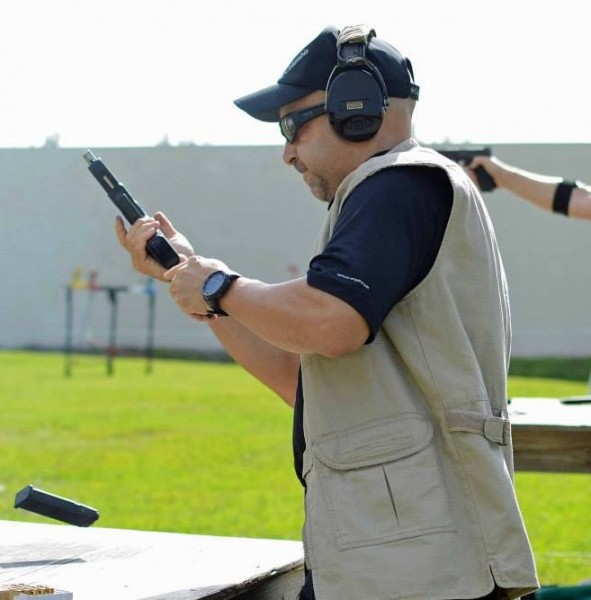 Last time we left off on the crusade to make competition safe for the tactical world, we were making the case that stress introduced into shooting causes interesting results. Being able to work through the stress of the timer will always improve your shooting ability.
Last time we left off on the crusade to make competition safe for the tactical world, we were making the case that stress introduced into shooting causes interesting results. Being able to work through the stress of the timer will always improve your shooting ability.
I just got back from competing in a major international shooting competition where I saw and experienced different levels of stress. The funny thing about stress (aside from actual physical stress) is that it’s only in the mind. That’s right. Stress is in the mind. Stress has nothing to do with shooting. Does it? What constitutes shooting? Lining up the sights and pulling the trigger. No where in that equation does the word “stress” make an appearance. “I hope I won’t miss”, “I suck at steel”, “I hate qualification” etc. All mental problems that have nothing to do with shooting. Being able to turn off the mental stress (conscious mind) and replace it with subconscious skill comes only with repeated practice. However, you can practice and practice by yourself for eternity, but you need a way to test it. That comes from shooting competitions.
Another by product of both the repeated practice and competitions is a higher ability to handle and manipulate your firearms (note: I say firearms not handgun, because you can practice and compete in handgun, shotgun and rifle these days). What is weapon manipulation? We tend to place high dollar words to make the layman feel our dogma has meaning. But in simple terms, weapon manipulation means being able to draw, reload and move without looking like Mr. Magoo (or Jar-Jar Binks if you were born after 1987).
One of the biggest things I observe a lot of LEOs have issue with when they either qualify or come to classes, is their ability to have effective gun handling. Under normal (non-competitive) circumstances, a draw should be under 2 seconds from either a retention holster or concealment. I’ve been witness to hundreds of qualifications and observed the draw habits of hundreds of officers and the majority have a hard time meeting the 2 second metric. Why? Isn’t being able to get the gun out of the holster an important function of the patrol officer? What I think happens, is once the officer initially learns how to draw the gun, it becomes an awkward exercise in straps, levers and clothing. It’s hard to remember all the steps that are necessary to have a smooth draw, so what happens is one of the following: Either the draw becomes a spastic pull and tug, yanking until the gun gets free OR it becomes ritualistically slow. Both are not good results for getting the gun in to the fight.
However, there is hope. Like any sport, repeated practice guarantees accomplished technique. But what forces someone to practice? I’ve known some pretty “tactical” people in my travels. They are dedicated people who practice their draws, go to range, and work out like madmen. In their mind, they can’t fail. They do what they have to do to keep their edge. God bless them. I sleep better knowing they are out there. But what about the rest of the “tactical” community? Do you spend a hour a day working on your draw? How often to you go to the range? And, what do you do when you get there?
See, there is a definite way to push the skill level up. Wait for it..shoot competition. Better weapons manipulation is a by product of routine handling and shooting the gun. Not everyone wants to go out and win, but I’ve seen even the worst grandmother (truthful) to the youngest shooter “manipulate” their handguns that put a lot of “tactical” folk to shame.
Please don’t take this as “competition” is great and “tactical” is bad. Believe me, I’m not trying to stir the pot for web hits. I’m trying to say if it’s good enough for grandma, then maybe the tactical guys should try it. In fact, a lot of the techniques used in the tactical firearms community come directly from the competitive world. Rob Leatham, Jerry Barnhart and Frank Garcia are a few of the competitive shooters who trained/train our special operations community. Reloading in the “workspace”, holding the rifle rail with the support hand fully extended and the thumbs forward pistol grip are all techniques that these competition guys brought to the tactical community. The way I look at it: If it’s good enough for CAG, DevGru, Tier 1 etc., well..maybe it’s good enough for me.
Bottom line, competitors have a drive to win or at least, not come in last. That drive pushes them to practice and go to matches. Follow me, at matches they have to draw fast, reload smooth and move with the gun. How many time have you’ve done that lately? I can go to 2-3 matches a week if I want. I practice every night. My gun handling has gone through the roof since I started competing.
Again I ask? How will this get me killed?…
Next up: Shooting at targets.



Great write up! I couldn’t have said it better myself.
It won’t get you killed. And as a competitor I wish I could hand this article out to every person I hear at a comp who says “well in real life….”